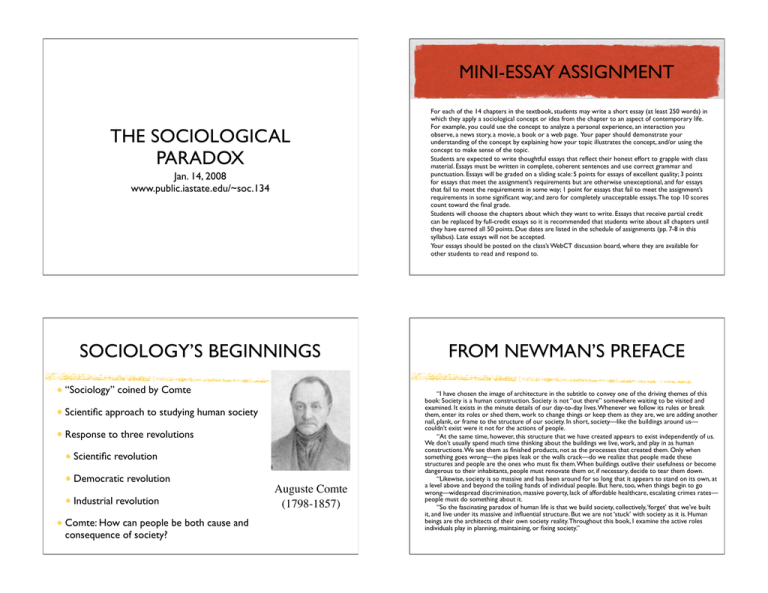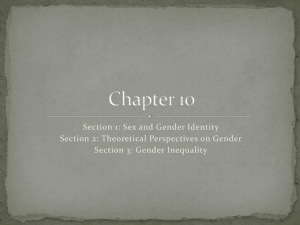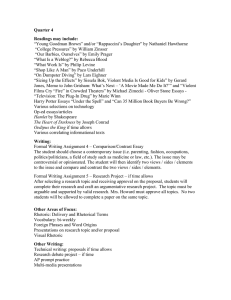MINI-ESSAY ASSIGNMENT
advertisement

MINI-ESSAY ASSIGNMENT THE SOCIOLOGICAL PARADOX Jan. 14, 2008 www.public.iastate.edu/~soc.134 SOCIOLOGY’S BEGINNINGS “Sociology” coined by Comte Scientific approach to studying human society Response to three revolutions Scientific revolution Democratic revolution Industrial revolution Comte: How can people be both cause and consequence of society? Auguste Comte (1798-1857) For each of the 14 chapters in the textbook, students may write a short essay (at least 250 words) in which they apply a sociological concept or idea from the chapter to an aspect of contemporary life. For example, you could use the concept to analyze a personal experience, an interaction you observe, a news story, a movie, a book or a web page. Your paper should demonstrate your understanding of the concept by explaining how your topic illustrates the concept, and/or using the concept to make sense of the topic. Students are expected to write thoughtful essays that reflect their honest effort to grapple with class material. Essays must be written in complete, coherent sentences and use correct grammar and punctuation. Essays will be graded on a sliding scale: 5 points for essays of excellent quality; 3 points for essays that meet the assignment’s requirements but are otherwise unexceptional, and for essays that fail to meet the requirements in some way; 1 point for essays that fail to meet the assignment’s requirements in some significant way; and zero for completely unacceptable essays. The top 10 scores count toward the final grade. Students will choose the chapters about which they want to write. Essays that receive partial credit can be replaced by full-credit essays so it is recommended that students write about all chapters until they have earned all 50 points. Due dates are listed in the schedule of assignments (pp. 7-8 in this syllabus). Late essays will not be accepted. Your essays should be posted on the class’s WebCT discussion board, where they are available for other students to read and respond to. FROM NEWMAN’S PREFACE “I have chosen the image of architecture in the subtitle to convey one of the driving themes of this book: Society is a human construction. Society is not “out there” somewhere waiting to be visited and examined. It exists in the minute details of our day-to-day lives. Whenever we follow its rules or break them, enter its roles or shed them, work to change things or keep them as they are, we are adding another nail, plank, or frame to the structure of our society. In short, society—like the buildings around us— couldn’t exist were it not for the actions of people. “At the same time, however, this structure that we have created appears to exist independently of us. We don’t usually spend much time thinking about the buildings we live, work, and play in as human constructions. We see them as finished products, not as the processes that created them. Only when something goes wrong—the pipes leak or the walls crack—do we realize that people made these structures and people are the ones who must fix them. When buildings outlive their usefulness or become dangerous to their inhabitants, people must renovate them or, if necessary, decide to tear them down. “Likewise, society is so massive and has been around for so long that it appears to stand on its own, at a level above and beyond the toiling hands of individual people. But here, too, when things begin to go wrong—widespread discrimination, massive poverty, lack of affordable healthcare, escalating crimes rates— people must do something about it. “So the fascinating paradox of human life is that we build society, collectively, ‘forget’ that we’ve built it, and live under its massive and influential structure. But we are not ‘stuck’ with society as it is. Human beings are the architects of their own society reality. Throughout this book, I examine the active roles individuals play in planning, maintaining, or fixing society.” INDIVIDUALS AND SOCIETY TOWARD A SOCIOLOGICAL VIEW OF LOVE Today’s graphics from www.postsecret.com Society “Our personal, everyday experiences affect and are affected by the larger society in which we live.… You will read about what society consists of and get a glimpse into sociologists! attempts to understand the two- way relationship between the individual and society.” (Newman, p. 1) Individuals “In America it is assumed that men and women marry because they are in love. There is a broadly based popular mythology about the character of love as a violent, irresistible emotion that strikes where it will, a mystery that is the goal of most young people… As soon as one investigates, however, which people actually marry each other, one finds that the lightning-shaft of Cupid seems to be guided rather strongly within very definite channels of class, income, education, racial and religious background… [and] one finds channels of [courtship] interaction that are often rigid to the point of ritual. The suspicion begins to dawn on one that, most of the time, it is not so much the emotion of love that creates a certain kind of relationship, but that carefully predefined and often planned relationships eventually generate the desired emotions. In other words, when certain conditions are met or have been constructed, one allows oneself to ‘fall in love’” (Peter Berger, Invitation to Sociology, p. 35). INDIVIDUALS AND SOCIETY Society Socialization Socialization: process through which one learns how to act according to the rules and expectations of a particular culture (p. 156) Individuals FUZZY BUNNY’S GUIDE TO YOU-KNOW-WHAT SOCIALIZATION & LOVE Sociologists: Patti & Peter Adler, Stephen Kless Method: Participant observation Research question: What qualities determine popularity of elementary school boys and girls? INDIVIDUALS AND SOCIETY Society Social control: various means by which a society encourages conformity to its rules and expectations Socialization Social Control Individuals SOCIALIZATION & LOVE Boys’ popularity factors: athletic ability, coolness, toughness, social skills, crossgender relations Cross-gender relations: By sixth grade, boys gained status for “going with” and “scoring” with girls Girls’ popularity factors: family background (money & permissiveness), physical appearance, social skills, academic success Social skills: Girls gained popularity by “going with” popular boys; boys’ popularity attaches to girls so popular girls wouldn’t go with less popular boys Physical appearance: Fashionable clothes, make-up & adherence to conventional beauty standards increased interest by boys and overall popularity; as early as kindergarten girls realize the connection between appearance and popularity Lessons: Popularity plays an important role in socialization to gender roles, including romantic ones; girls learn to gain popularity through attracting and “going with” boys; boys through “going with” and “scoring” with girls





